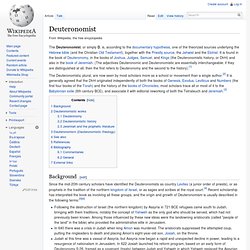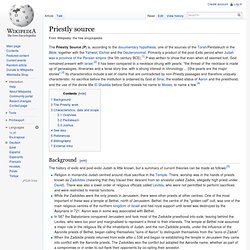

Documentary hypothesis. Diagram of the Documentary Hypothesis.

The documentary hypothesis (DH), sometimes called the Wellhausen hypothesis, proposes that the Pentateuch (the first five books of the Bible) was derived from originally independent, parallel and complete narratives, which were subsequently combined into the current form by a series of redactors (editors). Deuteronomist. The Deuteronomist, or simply D, is, according to the documentary hypothesis, one of the theorized sources underlying the Hebrew bible (and the Christian Old Testament), together with the Priestly source, the Jahwist and the Elohist.

It is found in the book of Deuteronomy, in the books of Joshua, Judges, Samuel, and Kings (the Deuteronomistic history, or DtrH) and also in the book of Jeremiah. (The adjectives Deuteronomic and Deuteronomistic are essentially interchangeable: if they are distinguished at all, then the first refers to Deuteronomy and the second to the history).[1] Background[edit] Following the destruction of Israel (the northern kingdom) by Assyria in 721 BCE refugees came south to Judah, bringing with them traditions, notably the concept of Yahweh as the only god who should be served, which had not previously been known.
Deuteronomistic works[edit] Deuteronomy[edit] Deuteronomistic history[edit] Elohist. Background[edit] Modern scholars agree that separate sources and multiple authors underlie the Pentateuch, but there is much disagreement on how these sources were used to write the first five books of the bible.[4] The explanation called the documentary hypothesis dominated much of the 20th century, but the 20th-century consensus surrounding this hypothesis has now broken down.

Those who uphold it now tend to do so in a strongly modified form, giving a much larger role to the redactors (editors), who are now seen as adding much material of their own rather than as simply passive combiners of documents.[5] Among those who reject the documentary approach altogether, the most significant revisions have been to combine E with J as a single source, and to see the Priestly source as a series of editorial revisions to that text.[6] The alternatives to the documentary approach can be broadly divided between "fragmentary" and "supplementary" theories.
Characteristics, date and scope[edit] Jahwist. The Jahwist, or Yahwist, often abbreviated J in exegetical discourse, is the proposed source of the Jahwistic (Yahwistic) traditions of the Pentateuch (Torah).

It gets its name from the fact that it characteristically uses the term Yahweh (German Javeh, Hebrew YHWH) for God in the book of Genesis. During most of the 20th century the dominant belief among scholars was that the Torah had been composed by intertwining four originally separate and complete documents, of which the Yahwist was one—this was called the documentary hypothesis. In the last quarter of the 20th century the consensus over the documentary hypothesis unravelled, and although it still has supporters there are now many alternatives. These alternatives can be broadly divided between "fragmentary" and "supplementary" models (hypotheses). Background[edit] Characteristics[edit] J has a particular fascination for traditions concerning Judah, including its relationship with its neighbour Edom.
Michael D. Priestly source. The Priestly Source (P) is, according to the documentary hypothesis, one of the sources of the Torah/Pentateuch in the Bible, together with the Yahwist, Elohist and the Deuteronomist.

Primarily a product of the post-Exilic period when Judah was a province of the Persian empire (the 5th century BCE),[1] P was written to show that even when all seemed lost, God remained present with Israel.[2] It has been compared to a necklace strung with pearls: "the thread of the necklace is made up of genealogies, itineraries and a terse story line, with a strong interest in chronology ... [t]he pearls are the major stories".[3] Its characteristics include a set of claims that are contradicted by non-Priestly passages and therefore uniquely characteristic: no sacrifice before the institution is ordained by God at Sinai, the exalted status of Aaron and the priesthood, and the use of the divine title El Shaddai before God reveals his name to Moses, to name a few.[4]